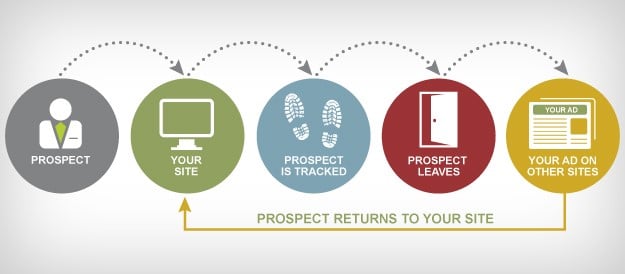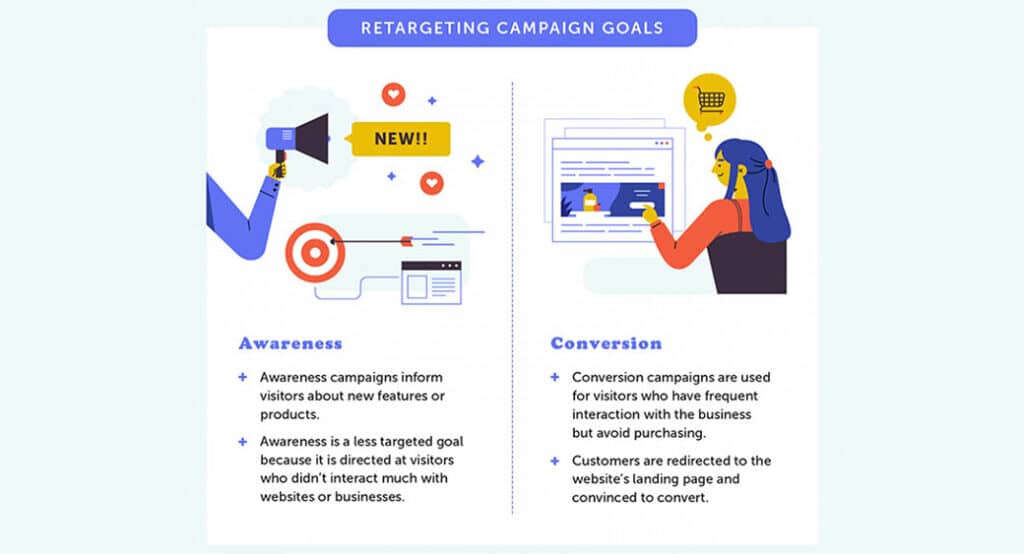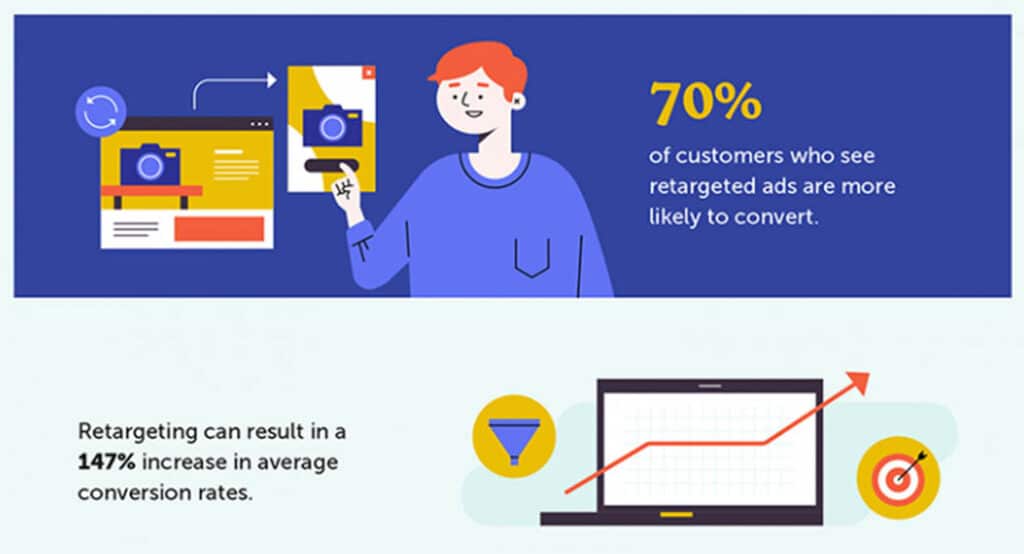You have done a lot of work to build your website and attract visitors. But soon after browsing the website, your visitors leave without a trace. Why did they leave? And how can you bring them back?
In most cases, only 2% of web traffic converts on the first visit. While it’s typical for visitors to leave without making a sale, you need to find a way to entice the other 98% to come back to your website. Retargeting campaigns are one of the best ways to get back in front of those potential customers and regain their attention.

Retargeting allows you to serve cookies to capture visitors who come to your website, enabling you to later show ads to these visitors as they visit other websites. It’s an effective marketing tool because it places your products/services in front of people who have already shown interest in your brand and who are already familiar with your business. Developing the right retargeting strategy for your business will bring potential customers back to your website and ready to buy.
Before we dive in, let’s look at some stats to show you why retargeting works:
- 33% of marketers say that the primary goal they seek from retargeting is an increase in brand revenue and acquisition of new customers
- Retargeting has the ability to increase conversion rates by almost 150%
- 90% of marketers say retargeted ads perform as well as or better than other digital marketing avenues
- Retargeted visitors are 70% more likely to convert on a website compared to those who aren’t targeted for the second time
Set Retargeting Goals
Before choosing your retargeting strategy, set clear goals for your marketing campaign. After all, how can you know if you are succeeding if you don’t even know where you are going?
First, determine who you’re targeting and why. You might be trying to raise awareness for your brand or convert visitors into buyers. Each of these goals requires a different retargeting strategy.

How people have interacted with your brand in the past should also impact which advertisement you use. For instance, if someone visited your website but didn’t make a purchase, then an ad hinting at the value your product or service offers would be beneficial. However, if someone is already a customer, an ad promoting a new product or service would be more appropriate.
More specifically, look at how you can set up retargeting ads that are relevant based on the pages site visitors have landed on but did not convert. Doing so creates a sense of personalization. In fact, 80% of customers are more likely to make a purchase from a company that provides personalized experiences.
Choose the Right Retargeting Strategy
There are a number of retargeting strategies you can use for your business. If you’re new to retargeting, you should stick to one or two methods before diving into more. Below are four types of retargeting strategies to consider.
1. Search Retargeting
Search retargeting shows ads based on search history and is based on general web searches. These people have not engaged with your site, but they have looked for content similar to what you offer. For example, if a person looks for information on hiking boots, they’ll later be shown an advertisement for a sale going on at a local outdoor recreation store. This method allows you to attract customers interested in the products and services that are similar to what you offer.
2. Site Retargeting
Site retargeting focuses on people who have already visited your website. According to a study by Episerver, 92% of consumers are visiting a brand’s website for reasons other than making a purchase. They may just be browsing or doing research to inform a future purchase. Site retargeting allows you to get your brand back in front of potential customers and entice them to make a decision about your product. For example, if someone added items to their cart but never finished the checkout process, a site retargeting ad would display a discount code for their first purchase.
3. Social Retargeting
Social media is a powerful marketing tool, especially for retargeting ads. On average, people spend over two hours each day on social media platforms. Go where your customers are already spending their time and find ways to retarget through Facebook, Instagram, and Twitter. Dynamic ads work well on Facebook and Instagram by displaying products people have viewed in the past. All you have to do is upload your product catalog to the platform, set up the campaign, and the ads will generate based on user experiences.

4. Existing Customer Retargeting
According to Adobe Digital Index, repeat customers are nine times more likely to convert than a first-time visitor. Existing customers are perfect for promoting new products or services. By displaying ads about new products, you remind previous customers about the value your brand offers and show them that your company is still relevant.
Optimize Your Ads
If a potential customer is seeing your brand everywhere, they’ll get sick of the constant pressure to buy and will deliberately ignore your ads. You want people to have a good experience with your brand, so optimize your ads the right way.
You can optimize your retargeting ads in a number of ways:
- Set a limit for ad frequency to somewhere around 15 times in a 30-day period. This way your brand is still appearing regularly, but not every time a customer opens a new window.
- Make sure the ad is relevant to the customer. For instance, you should have different ads for people who added items to their cart before leaving your site and people who just viewed a blog post. Relevant ads are more likely to catch the eye and drive conversions.
- Rotate advertisements so you don’t deal with ad fatigue. You should have three to five different versions of an ad, and they should all have the same type of conversion goal. Diversifying your ads will entice target customers to revisit your website.
Wrapping It Up
Retargeting ads are 76% more likely to get click-throughs than normal display ads. The personalized marketing of retargeting strategies helps you reach more customers and increase conversion rates. As long as you set the right goals, select an effective retargeting strategy, and optimize your ads, you’re sure to improve sales for your business.
Finally, continue A/B testing in conjunction with your landing pages. It’s important to understand which ads generate the most clicks and how you can then turn those clicks into conversions.






One Response